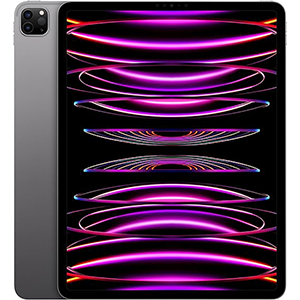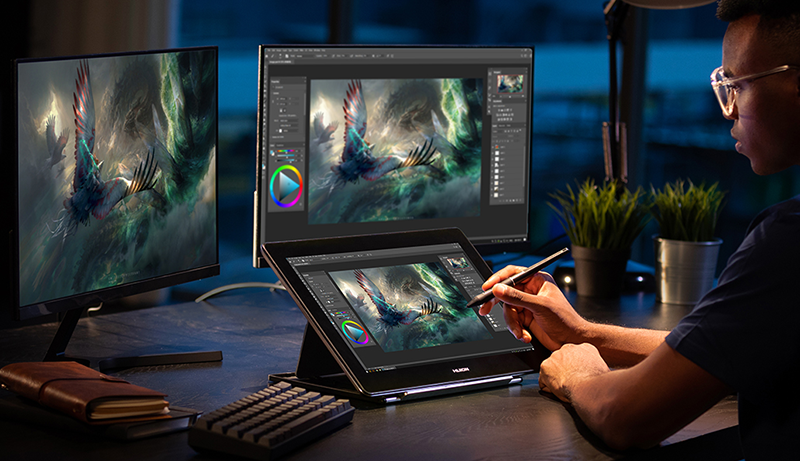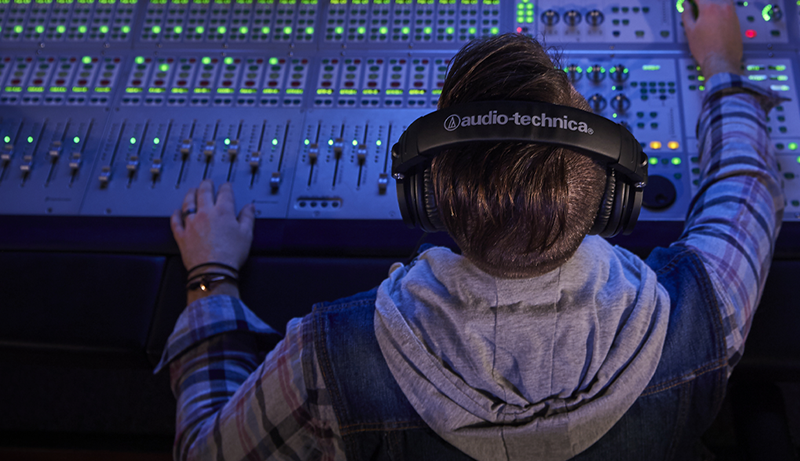Are you a beginner artist feeling overwhelmed by the wide range of digital art tools available? Drawing tablets are an excellent choice for newcomers, offering a variety of features to help you create stunning artwork with ease. However, with so many options on the market, it can be challenging to find the right one for you.
To simplify your search, I’ve reviewed the top drawing tablets, both with and without screens, ideal for those new to digital art. Whether you’re transitioning to digital or looking to upgrade your current setup, this guide will help you find the perfect tablet to meet your needs.
After evaluating various factors like processing power, display quality, ease of use, and stylus compatibility, I’ve found the HUION KAMVAS Pro 16 Plus to be the best choice for beginners. It excels in all areas except portability, making it a fantastic option for those starting their digital art journey.
1. HUION Kamvas Pro 16 Plus

I chose the HUION Kamvas Pro 16 Plus 4K UHD Graphics Drawing Tablet for its promise of exceptional visual fidelity and user-friendly functionality. Now, it has become an indispensable part of my daily drawing routine.
At the core of the Kamvas Pro 16 Plus is its impressive 15.6-inch 4K UHD display, a feature that immediately captured my attention. The level of detail and clarity it offers is unmatched. Whether I’m sketching intricate lines or blending colors, the combination of full lamination technology, an IPS panel, and anti-glare glass ensures a seamless, distraction-free experience.
For me, color accuracy is crucial, and the Kamvas Pro 16 Plus doesn’t disappoint. Powered by Quantum Dot technology, it delivers a vibrant and true-to-life color spectrum with a 145% sRGB wide color gamut. Combined with a 1200:1 contrast ratio, it offers deeper blacks and brighter whites, allowing every piece I create to stand out with the depth and dimension it deserves.
The tablet also excels in connectivity. The dual USB-C ports provide flexibility to connect to various devices, including my PC and smartphone. The convenience of connecting via a single 3-in-1 HDMI cable or a full-featured USB-C cable has streamlined my workspace, reducing the clutter of unnecessary wires.
Drawing on the Kamvas Pro 16 Plus feels incredibly natural, thanks to PenTech 3.0+ technology. The reduced retraction distance and battery-free stylus with tilt recognition closely mimic the experience of drawing with a real pen on paper.
However, the tablet isn’t without its drawbacks. The lack of physical shortcut buttons is a noticeable shortcoming, as quick access to tools and functions can significantly speed up the drawing process. Additionally, while I occasionally use my Android phone for sketches, the experience is less than optimal, which can be frustrating.
In conclusion, the HUION Kamvas Pro 16 Plus is a tablet that not only meets but exceeds the demands of digital drawing. The display quality, color accuracy, and intuitive drawing experience set it apart from other tablets on the market.
2. Apple iPad Pro

The Apple iPad Pro is everything you’d expect from a top-tier tablet—powerful, fast, and incredibly versatile. But what truly set it apart for me was its unmatched battery life, making it a reliable companion for long, uninterrupted drawing sessions, no matter where inspiration struck.
The iPad Pro’s ease of use, combined with its impressive processing power, delivered a seamless experience from initial sketch to final artwork. Powered by the M2 chip, it effortlessly handled everything I threw at it, from intricate layers in digital paintings to high-resolution graphics for design projects. This power, coupled with 8GB of RAM and fast Wi-Fi connectivity, ensured smooth multitasking between large files and apps.
The standout feature of the iPad Pro was its battery life. With up to 10 hours of use on a single charge, it offered the freedom to work from anywhere—whether in my studio, at a coffee shop, or on the go.
Visually, the iPad Pro’s 12.9-inch Liquid Retina XDR display was nothing short of breathtaking. Its sharpness, color accuracy, and responsiveness made drawing on it an absolute pleasure. ProMotion technology and True Tone enhanced the visuals, making them not only stunning but also reducing eye strain during long creative sessions.
To fully utilize the iPad Pro for drawing, I invested in the Apple Pencil (2nd generation). Despite the extra cost, the pencil’s pixel-perfect precision, tilt and pressure sensitivity, and lag-free performance were well worth it. However, while the large display was perfect for detailed work, it did compromise the device’s portability.
In summary, the Apple iPad Pro greatly enhanced my digital art creation process. Its high performance, ample storage, and exceptional battery life, along with the stunning capabilities of its display, made it an invaluable tool in my artistic journey.
3. Wacom One HD

I’ve used the Wacom One HD for many of my design and digital art projects, and it has quickly become one of the best pen and display drawing tablets I’ve ever used. Here’s what my experience has been like:
The 13.3-inch display of the Wacom One HD provided a workspace that felt both spacious and intimate. With a resolution of 1920 x 1080, every detail of my work was crisp and clear, enhancing the precision of my art. The vibrant color accuracy, featuring a 72% NTSC/99% sRGB color gamut, brought my creations to life on the screen, reflecting the vividness I aimed to achieve.
The Pro Pen 2 stood out with its natural feel and responsiveness, offering 4096 levels of pressure sensitivity for exceptional control and nuance in my work. I was initially concerned about losing the tactile feedback when transitioning from pencil and paper to a digital canvas, but the battery-free design of the Pro Pen 2 made the drawing experience as intuitive and natural as ever.
The tablet’s adjustable legs provided the ergonomic support I needed during long hours of work, showing that Wacom thoughtfully considered the comfort and well-being of artists.
However, the tablet does have some limitations. The absence of Express Key buttons was a challenge in my workflow, as I had grown accustomed to using shortcuts in my digital art process.
Overall, the Wacom One HD is an excellent choice for art students and aspiring artists seeking a balance of performance, affordability, and portability. Its high-quality display, responsive stylus, and broad compatibility make it a standout option.
4. Wacom Cintiq Pro 17

My decision to use the Wacom Cintiq Pro 17 was driven by the need for a tablet that could deliver both high resolution and precise color reproduction. Its 17.3-inch 4K UHD touchscreen brought my most ambitious projects to life with a level of accuracy and vibrancy I had never experienced before.
The display quality of the Cintiq Pro 17 was transformative for my work. With 4K resolution and the capability to display over a billion colors, every detail of my art was rendered with stunning precision. The factory-calibrated color accuracy across Adobe RGB and sRGB profiles was crucial in ensuring that what I saw on screen matched my final prints or digital outputs, removing any guesswork from my color management process.
Another standout feature was the Wacom Pro Pen 3, which came with the Cintiq Pro 17. With 8192 levels of pressure sensitivity, the pen allowed for delicate variations in line weight and opacity, closely mimicking the control of traditional media. The customizable features, such as adjustable weight and balance, made long drawing sessions more comfortable and intuitive.
The tablet’s compatibility with a wide range of operating systems and creative software was a huge benefit to my workflow. Customizing ExpressKeys and utilizing multi-touch gestures streamlined my creative process, allowing for quicker adjustments and more time focused on creating art.
The versatility of stand options, including adjustable angles for an ergonomic setup, further enhanced my drawing experience. I could design and draw for hours on end without experiencing significant discomfort.
However, the Cintiq Pro 17 did come with its challenges. While the Adobe RGB coverage was generally impressive, it fell short for some of my more color-critical work. Additionally, the added cost of purchasing an adjustable stand separately was a drawback, though the benefits of having a flexible drawing angle were undeniable.
Overall, the Wacom Cintiq Pro 17 meets the critical needs of artists with its exceptional display and pen technology, making it a powerful tool for creating complex and color-rich artworks.
5. XPPen Artist24 Pro

For those seeking a large workspace to bring their digital art to life, I highly recommend the XPPen Artist24 Pro.
As a designer or artist, you probably find it frustrating to constantly zoom in and out on smaller tablets to work on fine details without losing sight of the overall composition. The XPPen Artist24 Pro, with its expansive 24-inch display and 2560 x 1440 resolution, completely alleviated this issue, offering crisp and vivid clarity that significantly enhanced my drawing experience.
Connectivity is another area where the Artist24 Pro truly excels. The USB-C to USB-C connection streamlined my setup, allowing me to connect directly to my MacBook Pro without the need for multiple adapters. This not only simplified my workspace but also made the transition from concept to creation smoother and faster.
Customization became an integral part of my daily workflow with the tablet’s 20 customizable shortcut keys and two dial wheels. By assigning shortcuts for brush size, layer switching, and other frequently used actions, I noticed a significant improvement in my efficiency.
However, fully adapting to the customizable features took some time. Optimizing the shortcut keys and dials to fit my workflow required a bit of trial and error. Additionally, the tablet’s high resolution and color accuracy demanded more from my computer, which occasionally led to slower processing times for complex projects.
Reflecting on my experience with the XPPen Artist24 Pro, its advantages have profoundly impacted my approach to digital art. The tablet not only met but exceeded my expectations, offering a combination of precision, efficiency, and expansive scale that has transformed how I create.
Conclusion
Choosing the right drawing tablet can have a profound effect on a beginner’s creative workflow and productivity. When selecting the best drawing tablet for beginners, it’s important to consider factors like tablet size, stylus responsiveness, pressure sensitivity, and software compatibility.
Based on my experience, I highly recommend the HUION KAMVAS Pro 16 Plus as the top choice for beginners, thanks to its expansive display, excellent color accuracy, and intuitive drawing experience.
What about you? Which tablet are you leaning towards? I’d love to hear your thoughts in the comments below!




